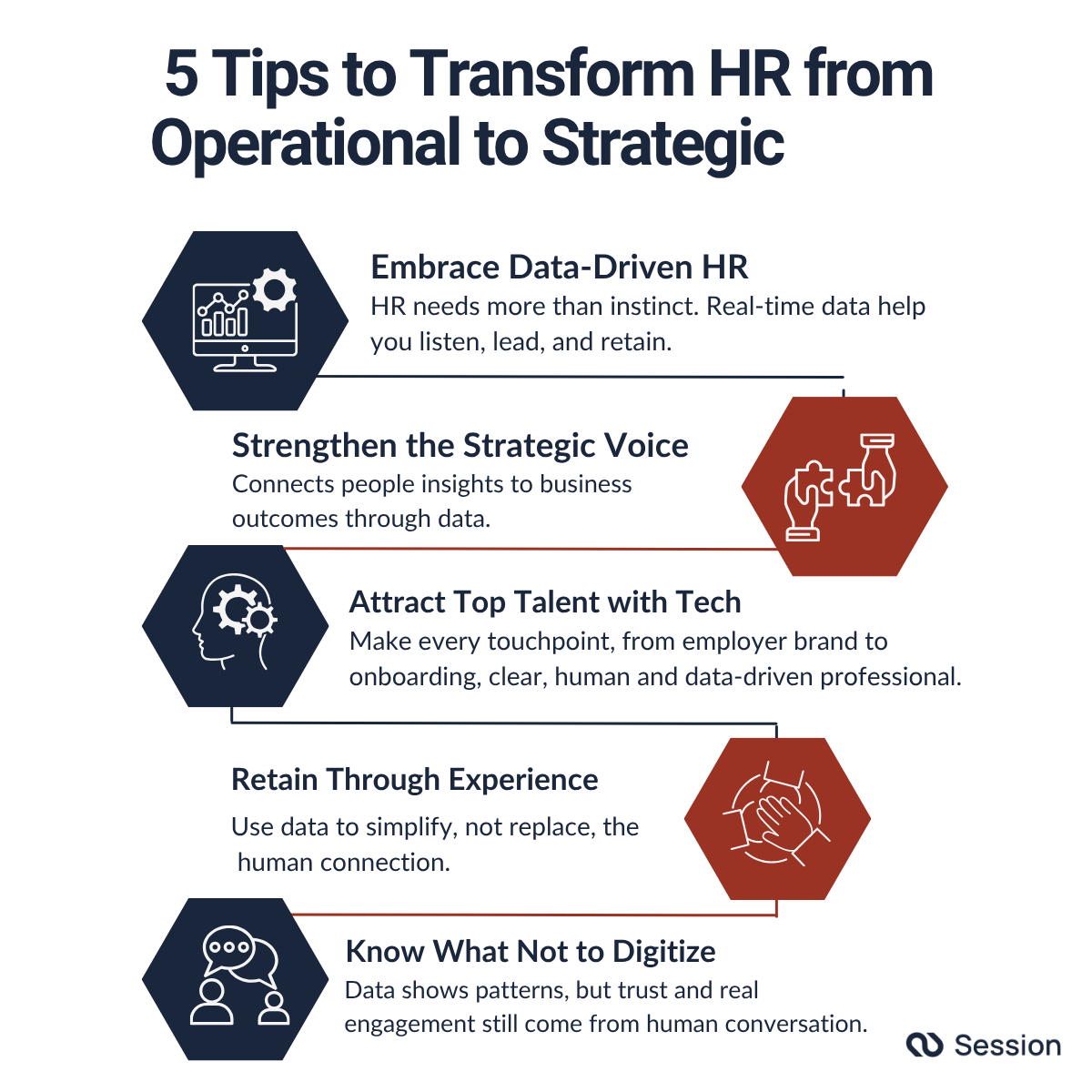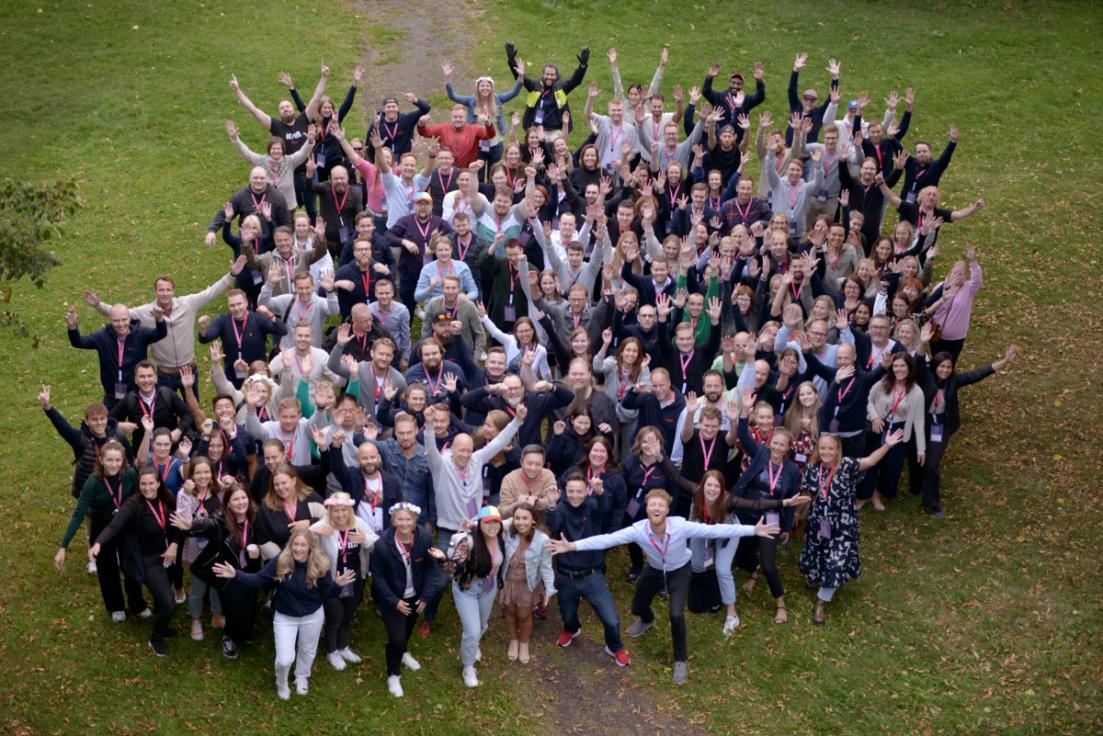HR has come a long way. Just ten years ago, it was still seen by many as a support function; focused on hiring, payroll, and policies. Fast forward to today, and the most forward-thinking organizations are treating HR not just as part of the business, but as a key driver of it.
Why? Because people are the business. And understanding how they feel, perform, grow, and stay is a strategic win.
With better tools, real-time data, and a growing recognition of the power of culture, HR now has the opportunity to step confidently into a more influential role. This shift isn't about abandoning the human side of HR. It's about using data and tech to amplify it.
In this guide, we’ll walk you through how to move from operational to strategic HR, with real, actionable steps. Because if you're ready to lead at a new level, the tools are here.

1: Embrace Data-Driven HR
HR still carries a reputation for being gut-feel heavy. Instincts matter, but in a fast-moving workplace, they’re just not enough on their own. If you want a seat at the table (and to stay there), you need something more solid: data. Not overwhelming dashboards, just honest, human signals from your team.
74% of employees say they’re more likely to stay at a company where they feel heard. So, start there.
Here’s what to do:
- Audit your current tools. What’s running on autopilot, and what’s still buried in email chains or printed forms?
- Add something lightweight but powerful: a pulse survey, a check-in bot, anything that helps you listen consistently.
- Choose one or two engagement or performance benchmarks to track each quarter.
These actionable steps are all about showing up with a clearer picture of how your people are doing, and making better decisions because of it.
2: Strengthen Your Strategic Voice
Being invited to the conversation is one thing. Being listened to is another. If you want your input to land, it needs to be rooted in more than instinct.
Show up with data that tells a clear story. Not just how people are feeling, but how it’s showing up in performance, retention, and growth. Translate engagement scores, DEI metrics, and development trends into business outcomes leadership cares about. McKinsey’s report on performance management highlights that organizations aligning their people strategy with business goals are 4.2 times more likely to outperform competitors in revenue growth and profitability.
Furthermore, don’t wait for someone to ask. Initiate and take the action by sharing regular updates, spotting patterns early, and speaking with clarity. When you can connect the people's side to the business side, your voice becomes a key part of the strategy.
3: Attract for Top Talent with Tech
Attracting great people starts long before the interview. From the moment someone hears about your company, the experience should feel modern, clear, and intentional.
That means using tools that make applying easy, not frustrating. It means your employer brand needs to be consistent everywhere. Whether in a job post, a social ad, or a LinkedIn update. And most importantly, it means showing your culture through video, not just describing it in words. Video works because it’s real; it lets candidates feel the energy, meet the people, and get a genuine sense of what it’s like to work with you beyond the job description.
A LinkedIn Talent Solutions report from 2024 shows that 75% of candidates research a company’s brand before applying, meaning your employer brand needs to be consistent and engaging across all channels.
When the offer comes, onboarding should feel just as seamless. Considering contracts to day-one intros, every touchpoint should show new hires they’ve joined a company that’s both organised and thoughtful, and ready for them.
4: Focus on Retention Through Experience
Keeping great people isn’t about job perks, it’s about how the day-to-day actually feels.
Begin by mapping the entire employee journey. Identify the pain points and spot where processes feel clunky or confusing. Then, use technology to simplify, not complicate. Whether it’s providing easier access to learning, streamlining workflows, or offering tools that make hybrid work more manageable, the goal is to remove friction. While 70% of C-suite leaders believe HR should focus less on productivity and more on unlocking human potential, only 20% feel that shift is actually happening today.
But remember, data is only useful if it leads to something. Measure what matters, and use those insights to start real conversations. The goal isn’t to replace the human side, it’s to support it with clarity and consistency.
5: Know What Not to Digitize
Not everything can be measured, and not everything that can be measured actually matters. Some things need to be felt in the room. A shift in tone during a check-in. An offhand comment in a 1:1. The kind of insight that only comes from slowing down and really listening.
A 2025 study by McKinsey found that organizations combining data insights with regular 1:1 coaching and conversations see 30% higher employee engagement than those relying on data alone.
Data helps you spot patterns, but it won’t tell you why someone’s disengaged or how a leader is really showing up. For that, you still need conversation. Coaching. Space to talk without the purpose of filling in boxes. The best tech supports human connection, yet it doesn’t replace it. And even today, in the moments that matter the most, trust is still built face-to-face.
Conclusion
Modern HR wears many hats; analyst, coach, and translator. You’re the bridge between what people truly feel and what the business needs to thrive. Data gives you evidence; empathy gives you understanding. Together, they create a perspective no one else can offer, one that connects numbers to real human stories.
Your seat at the table isn’t just earned by the figures you present. It’s earned through the clarity you bring, the context you provide, and the care you show for both people and business outcomes. This blend of insight and humanity is what makes HR indispensable, not just relevant, but essential to shaping the future of work.












